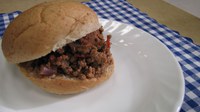Prairie Fare: Grocery Shopping 101
(Click an image below to view a high-resolution image that can be downloaded)
By Julie Garden-Robinson, Food and Nutrition Specialist
NDSU Extension Service
As I entered the grocery store parking lot with my 21-year-old son driving, I had a flashback of when he was young enough to ride in the child seat of a grocery chart.
On that day 20 years ago, I had just purchased groceries for the week, and I parked the cart right outside the door of our vehicle to load him in his car seat. I leaned in our vehicle to reposition the car seat a bit and then I turned back to retrieve my toddler.
He and the cart were sailing across the parking lot in a gust of Fargo’s forceful wind.
I ran after him, squealing. I didn’t know I was a sprinter. In a few seconds, I caught up to my saucer-eyed son hanging onto the cart handle for dear life. Fortunately, my son was fine, and I didn’t have a heart attack. No parked or moving vehicles were near us in the lot. I learned I had to hold the cart in place with my foot after that.
In living on his own, my college-aged son has learned that groceries are a big expense in the household budget. The “Bank of Mom” would be filling his pantry, fridge and freezer; however, he had to put up with me reminding him how to shop and save money.
Usually I suggest beginning with a written grocery list. Planning menus for the week with the store grocery ads at hand helps save money and increases shopping efficiency.
Because this was a spur of the moment trip, we started with the coupon bin in our grocery shopping adventure. I questioned him about his food supply as we walked.
Fortunately, we were at the store during a “good coupon week.” I reminded him about comparing the prices of name-brand and store-brand foods. He quickly learned that buying the store-brand items usually is a money-saving strategy.
He put the name-brand shredded cheese back on the rack and picked up the store brand. He likes to melt cheese on tortillas, so we looked for tortillas. We examined the price per ounce (unit price) and picked up the best deal.
My son always was my “calf” at home. He nabbed a gallon of nonfat milk, and we had a coupon for low-fat chocolate milk. Yes, chocolate milk has some extra calories, but it has the nine essential nutrients of “regular” milk. Researchers have shown that chocolate milk is an excellent sports recovery beverage.
I almost could see my son’s chocolate milk mustache from yesteryear. He added a jug of chocolate milk to the cart, too.
When we reached the bread aisle, I tried to entice him to get the whole-grain bread. According to today’s nutrition guidelines, we are supposed to make at least half of our grain choices whole grain. He grinned at me and reached for the white bread.
White bread has B vitamins and iron, along with energy-providing carbohydrates. I wanted him to eat the bread, so he got his wish.
“Well, you’ll be receiving lots of vegetables later so you get your fiber,” I added with a grin.
“Do you have any pasta?” I asked. He nodded. At the meat section, we found some frozen meatballs that he could add to canned spaghetti sauce for a quick meal. We added ground beef and frozen chicken to our cart.
“Are you eating any fruits and vegetables these days?” I prodded as we went down the canned fruit aisle.
“I’m out of vegetables, but I have a big jar of applesauce,” he said. I felt nostalgic because I remembered the poster at his child-care center where applesauce was listed as his favorite food.
The latest dietary guidelines still suggest filling half our plate with fruits and vegetables of a variety of colors. At his age and size, he needs at least 4 1/2 cups of fruits and vegetables per day, the same as most adults. He needed more than applesauce in the mix.
“You can pick out some fresh fruit, too,” I said. He added a bag of grapes and cluster of bananas.
He had been my “unofficial research project” as a child when I tried to entice him to eat vegetables. He used to eat his vegetables first “to get it over with.” I was happy to see him pick out a few bags of mixed vegetables in the frozen food aisle.
As we were heading toward the checkout counter with a fairly full cart, I noted a couple more things to buy. I bought him two sizes of freezer bags. We talked about freezing part of the loaf of bread and tortillas and dividing up some other foods into meal-sized amounts.
Finally, I saw his favorite cookies beckoning him.
“Do you want a package of cookies?” I asked.
Was there any doubt? Of course, you can fit an occasional treat in an overall healthful diet.
“Thanks, Mom. I will be eating really well,” my son said with sincerity as he dropped me off at home.
We have lots of resources and recipes on the NDSU Extension Service website (https://www.ag.ndsu.edu/food) for people of all ages and stages of life. Click on “Food Preparation” and see the “Cooking 101” series for quick and easy meals.
I have supplied my son with a slow cooker, so here’s a four-ingredient recipe that he can make. We’ll see how this goes.
4-ingredient Slow Cooker Sloppy Joes
1 pound extra-lean ground beef
1/2 onion, finely chopped
1/4 c. water
1 (6-ounce) bottle chili sauce
Salt and pepper to taste
In a skillet, cook ground beef until brown and crumbly. Drain thoroughly and place in a small slow cooker. Add water, onion, chili sauce, salt and pepper; mix well. Cook on low for four to six hours, until onions are tender. Serve on wheat buns.
Makes five servings. Each serving (not including the bun) has 150 calories, 3.5 grams (g) fat, 1 g protein, 11 g carbohydrate, 0 g fiber and 60 milligrams sodium.
(Julie Garden-Robinson, Ph.D., R.D., L.R.D., is a North Dakota State University Extension Service food and nutrition specialist and professor in the Department of Health, Nutrition and Exercise Sciences.)
NDSU Agriculture Communication - Sept. 22, 2016
| Source: | Julie Garden-Robinson, 701-231-7187, julie.garden-robinson@ndsu.edu |
|---|---|
| Editor: | Ellen Crawford, 701-231-5391, ellen.crawford@ndsu.edu |



